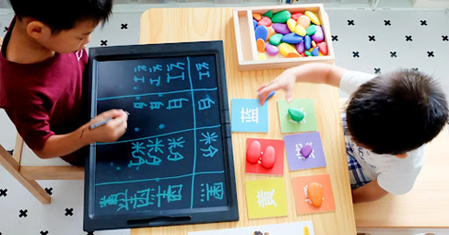How to Teach Mandarin to Beginners using storytelling
 Our first experiences of language are usually when someone — parent or carer — read you a story, and it’s a real skill. The reader will utilise emphasis, facial expressions, looks of surprise, sadness and humour,as well as using various intonations of voice. The reader is not expecting you to do anything other than listen and absorb theirenthusiasm. It's the same with learning a language, especially one that uses pictograms. Research shows that stories are essential for the stronger retention of content,since they present a wide range of the factors making up a language in context — demonstrating the correct way to use grammar and vocabulary.
Our first experiences of language are usually when someone — parent or carer — read you a story, and it’s a real skill. The reader will utilise emphasis, facial expressions, looks of surprise, sadness and humour,as well as using various intonations of voice. The reader is not expecting you to do anything other than listen and absorb theirenthusiasm. It's the same with learning a language, especially one that uses pictograms. Research shows that stories are essential for the stronger retention of content,since they present a wide range of the factors making up a language in context — demonstrating the correct way to use grammar and vocabulary.
Stories can make you relate to certain characters, empathising with or taking issue with what those characters stand for. Teachers are realising the benefits of reading meaningful stories early on and have found that reading simple material builds students’ confidence and prepares them for the enjoyable and beneficial habit of reading in Chinese. As they become more advanced, stories will make for inevitably beneficial reading material.
Learning Chinese can be a little daunting if it’s no one’s first language. With a limited vocabulary, however, students can find interesting ways to learn and can begin to create stories with a simple premise but leading to familiarity. Using as little as ten or eleven words in different contexts will show how one can gradually build a vocabulary, maybe adding a couple more words bit by bit. One important and, one would think, fairly obvious consideration is age-relative content. Use stories that are particularly suitable for a certain age group. That's not to say that adults can’t benefit from a good children’s book! Let's also not forget the value of pictures (a picture is worth a thousand words) — for example, Haiyun Lu’s books are charming stories with beautiful illustrations.
Audio and video, such as music videos, movie trailers, news and inspiring talks, are othervaluable resources, and, if you're using online material, look at The Chinese Reader Revolution website, where you can copy and paste Chinese text and use pinyin, with colours for each tone, word spacing and pop-up dictionaries. These browser add-ons allow you to hover over any Chinese words and see immediate pinyin and English interpretations of their meaning.
Some more tips
Read aloud with others —Ashared experience of learning makes the whole process fun, and working as a group will benefit all. Reading aloud from a picture book (pausing to let students enjoy the pictures) engages like no other. Act out the stories — What better way to see a language come to life than by acting out characters, using song and drama?
Use emotions —If a character is happy, use big smiles and thumbs up.Angry? Grumpy, furrowed brow and a growl. These may sound like clichés, but people remember them. Finally, use art — Get the class drawing and put it together as a mural. This will help the students "take ownership" and feel good being part of the creative process, too.


